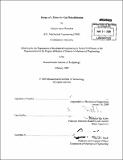| dc.contributor.advisor | Hermano Igo Krebs. | en_US |
| dc.contributor.author | Bosecker, Caitlyn Joyce | en_US |
| dc.contributor.other | Massachusetts Institute of Technology. Dept. of Mechanical Engineering. | en_US |
| dc.date.accessioned | 2011-05-23T17:59:37Z | |
| dc.date.available | 2011-05-23T17:59:37Z | |
| dc.date.copyright | 2009 | en_US |
| dc.date.issued | 2009 | en_US |
| dc.identifier.uri | http://hdl.handle.net/1721.1/62999 | |
| dc.description | Thesis (S.M.)--Massachusetts Institute of Technology, Dept. of Mechanical Engineering, 2009. | en_US |
| dc.description | Cataloged from PDF version of thesis. | en_US |
| dc.description | Includes bibliographical references. | en_US |
| dc.description.abstract | The ability to walk is important for independent living and when this capacity is affected by injury, gait therapy is the traditional approach to re-train the nervous system, to re-build muscle strength, to improve balance, and to re-train kinematics in order to reduce the stresses applied to bones and muscles. The importance of this problem is illustrated by the approximately 5.8 million stroke survivors alive in the US today and an estimated 700,000 strokes occurring each year. In fact, for stroke survivors with mild to moderate impairment, only 37% regain the ability to walk within one week post-stroke and 73% fall within the first six months. Falls are a leading cause of injury among Americans over 65 years old with over one third of this population experiencing a fall each year and an unsteady gait increases this risk. This growing population will require gait therapy. This thesis presents the design, development, fabrication, and proof-of-concept testing for a novel device to deliver gait therapy. While robotic devices exist, none of them take advantage of the concept of passive walkers and most focus on reproducing gait kinematics for impaired patients. Yet research has found that appropriate neural input is an important factor in efficacious therapy. For gait, this input would be the collision between the foot and the ground at heel-strike. The goal of this novel device is to allow patients to begin gait therapy before they are able to independently walk overground while maximizing the amount interface driven neural input during stepping in a safe environment. | en_US |
| dc.description.statementofresponsibility | by Caitlyn Joyce Bosecker. | en_US |
| dc.format.extent | 165 p. | en_US |
| dc.language.iso | eng | en_US |
| dc.publisher | Massachusetts Institute of Technology | en_US |
| dc.rights | M.I.T. theses are protected by
copyright. They may be viewed from this source for any purpose, but
reproduction or distribution in any format is prohibited without written
permission. See provided URL for inquiries about permission. | en_US |
| dc.rights.uri | http://dspace.mit.edu/handle/1721.1/7582 | en_US |
| dc.subject | Mechanical Engineering. | en_US |
| dc.title | Design of a robot for gait rehabilitation | en_US |
| dc.type | Thesis | en_US |
| dc.description.degree | S.M. | en_US |
| dc.contributor.department | Massachusetts Institute of Technology. Department of Mechanical Engineering | |
| dc.identifier.oclc | 720668014 | en_US |
